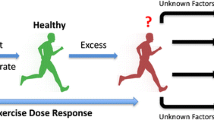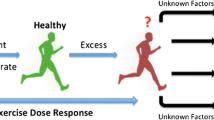Abstract
Despite the passage of time, masters athletes are still capable of incredible performances. Nevertheless, overuse injuries are the most common challenge in this escalating cohort. The incidence of exertion-related cardiovascular events is also greater among older athletes, especially men, highlighting the importance of a thorough preparticipation medical evaluation before entry into senior athletic training programs and competition. Accordingly, masters athletes with a moderate to high risk for coronary artery disease, who desire to enter vigorous competitive events, should undergo peak or symptom-limited exercise testing. Training programs for senior athletes should be individually tailored and focus on the predominant energy pathways and performance requirements for a given sport. Although competition and "personal bests" are important, protection against sickness and disability are increasingly listed as the primary participative motives of older athletes.
Similar content being viewed by others
References and Recommended Reading
Tinetti ME, Baker DI, McAvay G, et al.: A multifactorial intervention to reduce the risk of falling among elderly people living in the community. N Engl J Med 1994, 33:821–827.
Fiatarone MA, O’Neill EF, Ryan ND, et al.: Exercise training and nutritional supplementation for physical frailty in very elderly people. N Engl J Med 1994, 330:1769–1775.
Hakim AA, Curb JD, Petrovich H, et al.: Effects of walking on coronary heart disease in elderly men: the Honolulu Heart Program. Circulation 1999, 100:9–13.
Glass TA, de Leon CM, Marottoli RA, et al.: Population based study of social and productive activities as predictors of survival among elderly Americans. BMJ 1999, 319:478–483.
Maron BJ, Araújo CGS, Thompson PD, et al.: Recommendations for preparticipation screening and assessment of cardiovascular disease in masters athletes. Circulation 2001, 103:327–334. This landmark article provides prudent insights and advice to physicians concerning the screening and detection of cardiovascular disease, as well as recommendations for sports clearance and eligibility in masters athletes.
Bruce RA, Kusumi F, Hosmer D: Maximal oxygen intake and nomographic assessment of functional aerobic impairment in cardiovascular disease. Am Heart J 1993, 85:546–562.
Franklin BA: Survival of the fittest: evidence for high-risk and cardioprotective fitness levels. Curr Sports Med Rep 2002, 1:257–259.
Kelley GA, Sharpe KK: Aerobic exercise and resting blood pressure in older adults: a meta-analytic review of randomized controlled trials. J Gerontol A Biol Sci Med Sci 2001, 56:M298-M303.
Pescatello LS, Franklin BA, Fagard R, et al.: Exercise and hypertension. Med Sci Sports Exerc 2004, 36:533–553.
Pollock ML, Foster C, Knapp D, et al.: Effect of age and training on aerobic capacity and body composition of master athletes. J Appl Physiol 1987, 62:725–731.
Marti B, Howald H: Long-term effects of physical training on aerobic capacity: controlled study of former elite athletes. J Appl Physiol 1990, 69:1451–1459.
Menard D, Stanish WD: The aging athlete. Am J Sports Med 1989, 17:187–196. A well-written review, peppered with scientific data and anecdotal information, highlighting the fact that up to 50% of the physiologic decline associated with old age may be reversed.
Maron BJ, Epstein SE, Roberts WC: Causes of sudden death in competitive athletes. J Am Coll Cardiol 1986, 7:204–214.
Franklin BA, Fletcher GF, Gordon NF, et al.: Cardiovascular evaluation of the athlete: issues regarding performance, screening, and sudden cardiac death. Sports Med 1997, 24:97–119. A comprehensive review summarizing the physiologic basis and rationale for cardiovascular evaluations in athletes, with specific reference to electrocardiographic anomalies, cardiorespiratory fitness, medications, atherosclerotic and nonatherosclerotic causes of sudden cardiac death, identification of athletes at risk, and the limitations of conventional screening programs.
Thompson PD, Funk EJ, Carleton RA, et al.: Incidence of death during jogging in Rhode Island from 1975 through 1980. JAMA 1982, 247:2535–2538.
Maron BJ, Poliac LC, Roberts WC: Risk for sudden cardiac death associated with marathon running. J Am Coll Cardiol 1996, 28:428–431.
Scott WA, Couzens GS: Treating injuries in active seniors. Phys Sportsmed 1996, 24:63–68. A well-written paper, in a question and answer format, that provides a practical approach to managing overuse injuries, the most common sports injuries among older patients.
Maron BJ, Thompson PD, Puffer JC, et al.: Cardiovascular preparticipation screening of competitive athletes: a statement for health professions from the Sudden Death Committee (Clinical Cardiology) and Congenital Cardiac Defects Committee (Cardiovascular Disease in the Young), American Heart Association. Circulation 1996, 94:850–856.
Mazzeo RS, Cavanagh P, Evans WJ, et al.: Exercise and physical activity for older adults. Med Sci Sports Exerc 1998, 30:992–1008. This comprehensive scientific review highlights that participation in regular physical activity (both endurance and strength exercises) elicits a number of favorable physiologic and psychosocial responses that contribute to health aging.
Pollock ML, Gaesser GA, Butcher JD, et al.: The recommended quantity and quality of exercise for developing and maintaining cardiorespiratory and muscular fitness, and flexibility in healthy adults. Med Sci Sports Exerc 1998, 30:975–991.
Pollock ML, Franklin B, Balady GJ, et al.: Resistance exercise in individuals with and without cardiovascular disease: benefits, rationale, safety, and prescription. Circulation 2000, 101:828–833.
Senior Olympics News Update. www.SeniorJournal.com/ news/sports
In the long run: the Senior Games in Orlando, Florida next month will put older but fitter athletes on display. Time Magazine. September 27, 1999:154, 107.
Moss N: The psychology of the aging athlete. Clin Sports Med 1991, 10:431–444.
Ogles B, Masters K: Older versus younger adult male marathon runners: participative motives and training habits. J Sport Behav 2000, 23:130.
Lamb G: Ageless athletes. The Christian Science Monitor. May 14, 2003.
Roth C: C’mon tri it! IDEA Personal Trainer 2003, 14:6.
Rotsein G: Senior Olympics: athletes share a commitment to fitness and fun. Post-Gazette. May 20, 2003.
Pollock ML, Mengelkoch LJ, Graves JE, et al.: Twenty-year follow-up of aerobic power and body composition of older track athletes. J Appl Physiol 1997, 82:1508–1516.
Mengelkock LJ, Pollock ML, Limacher MC, et al.: Effects of age, physical training, and physical fitness on coronary heart disease risk factors in older track athletes at twenty-year follow up. J Am Geriatr Soc 1997, 45:1446–1453.
Author information
Authors and Affiliations
Rights and permissions
About this article
Cite this article
Franklin, B.A., Fern, A. & Voytas, J. Training principles for elite senior athletes. Curr Sports Med Rep 3, 173–179 (2004). https://doi.org/10.1007/s11932-004-0069-y
Published:
Issue Date:
DOI: https://doi.org/10.1007/s11932-004-0069-y




